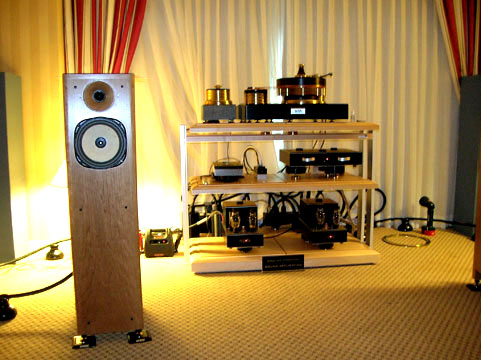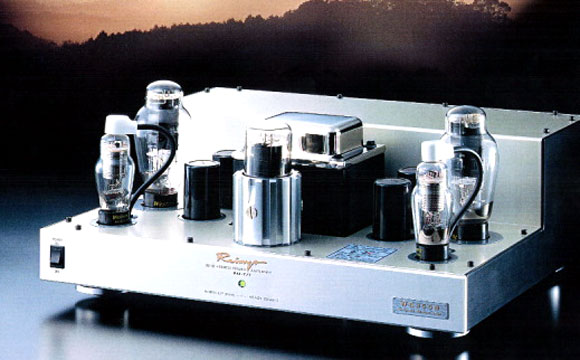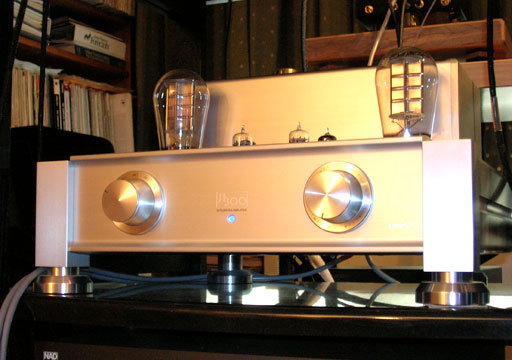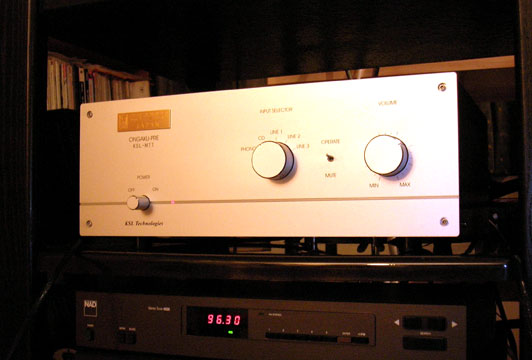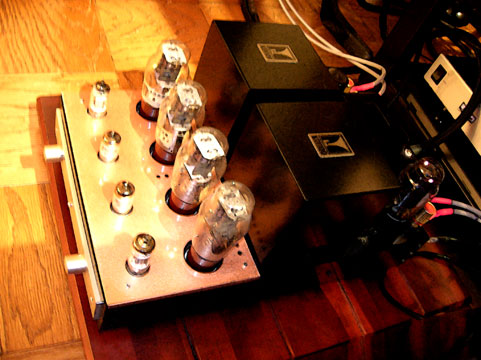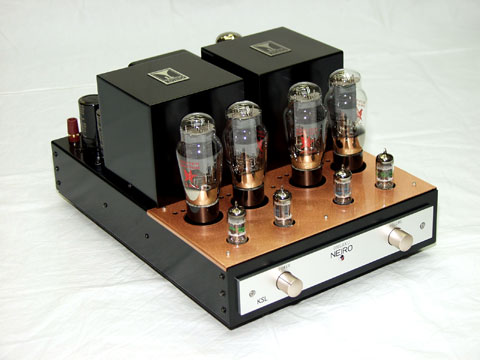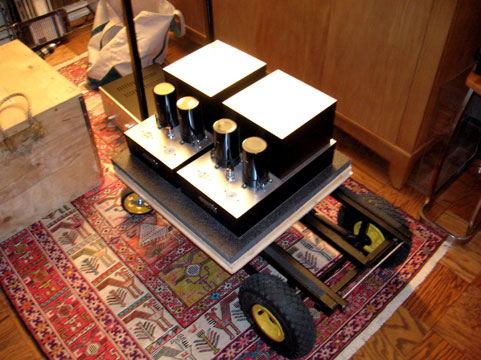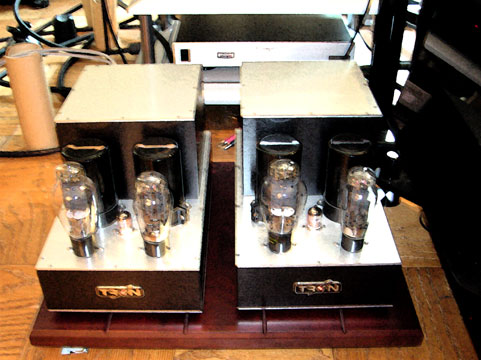|
You are reading the older HTML site
Positive Feedback
ISSUE
21
Encounters of the SET Kind: A
Survey of Select SET Amplification Photos by Nack; image processing and frescoes by Robinson
High Water Sound at HE2005E The First Watt (or Two) Did you know there's a renegade band of DIY desperados out there, lurking on the fringes of the High End? They would have us trade in our high-power systems and move towards inexpensive SET rigs, which they claim can put you closer to the performance, closer to the truth and, hence, give you greater satisfaction. These rigs do things beyond the reach of mainstream audio, so they say. Furthermore, these guys like to dwell on the simplicity and purity of the designs, and so notions of virtue and idealism accrue to them. The upshot, to the uninitiated like myself, is that the whole thing is shrouded in a burnished mystique. Nowhere is that shroud thicker than with single-digit-wattage gear. We've all heard stories about the fab "first watts," tales of purity unmatched by devices more powerful. It's true: even within the SET arena, where by definition all watts are Class A, the single-digit devices sound different than those with more juice. These are the ones people refer to when they invoke the mystique and the magic. I've heard the magic. Typically what comes to mind are inexpensive DIY amps harnessed to high sensitivity single driver speakers, easy loads that only need those first couple-a-watts to produce reasonable SPLs. Their presentation is lush and beautiful, sometimes intoxicating, always wonderfully warm, intimate and involving. But I've also heard things that bother me—most of the time they're mid-rangy, foreshortened at frequency extremes, too heavy on body, slow, dynamically challenged, and euphonic—which destroy the illusion of reality. For these reasons, I've kept my distance. It's not only me: the majority of audiophiles I talk to feel the same way. Now imagine a device that could marry the emotional connection and involvement with wide bandwidth, reasonably flat frequency response, satisfying low-end, and good macro-dynamics. (I didn't bother to list micro-dynamics because all SETs do that well, if not low-level detail). Folks don't know that low-wattage SET gear exists which can transcend the usual limitations. These exceptional devices are the ones I'm going to talk about now—this survey is limited to a few carefully selected eight-watters-or-less belonging to the transcendent group. Ancillary gear All of the gear was auditioned with the 100 dB sensitivity Hørning Hybrid Agathon Ultimate speakers, an important choice because of their dynamic capability and their 25Hz to 22,500KHz bandwidth—no sense mating them to a transducer with the very limitations under discussion. Matching pre-amps were provided along with the amps, thus eliminating one BIG variable. Ancillaries used, except with the Reimyo amplification, was as follows: interconnects and digital cables were Audio Note Japan LPz and LPd or the new DaVinci Audio cable; speaker cable was ANJ SPc or Harmonix SLC; power cords by Harmonix Studio Master. Occasionally I threw in a GTT Audio Absolute power cord when I needed to lighten the tonal palette. Conditioning was either minimal on the front-end or not needed at all. Supporting cast included the recently arrived racks and platforms from TAOC, a division of the Toyota group of companies (yes, they make the automobiles). All in all, I'd like to think I provided an environment conducive to fostering the magic. I got my first taste of the Reimyo PAT-777 300B stereo amp ($24,995) and CAT-777 pre ($15,495) paired with my Kharma CRM 3.2 speakers. This unlikely duo, the "puny" seven-watt amp and the 89dB sensitive CRM 3.2s, made some truly captivating sound (you can read all about it in my Reimyo review, so I'm going to keep this short).
PAT-777 The PAT-777 harnessed to the 100 dB sensitivity Hørning Agathon dished up the fabled 300B magic in spades. Of all the amps surveyed, the Reimyo conforms most to your expectations for a 300B, in terms of palpability, midrange sumptuousness and beautiful sound. Now, on those nights when it was really cookin', the Reimyo could float a stage in front of you with terrific palpability, the kind that sometimes happens when each instrument has its own 3-D volume in space. It gave the impression of a vast stage beyond the confines of the room—Harmonix/Reimyo tuning can do psycho-acoustic things like that. Turn the lights down low and maybe light a candle—get ready to be taken somewhere delightful beyond your sound room. It inspired grandeur—you're very quickly swept up into its spell. A lot of this is expected from a 300B device. Just so, the top-end fit the classic model and was a bit shelved down. The overall voicing was slightly dark. (Because of this the Reimyo took a lot of time and tweaking to acclimate to the Agathon-based system—just the opposite from when I used it with my Kharma 3.2s—where the extra low-end was welcome). And it was a very round sound. The transient presented a smooth wave front, and the follow through likewise—none of those pointed facets you commonly hear in "Hifi" treble. But the tone and timbre of this acoustic was vastly engaging and very beautiful. And there was the ever-present intimacy with soloists—whether the recording was spotlit or not, you still felt that connection. To pick a couple of critical nits, the whole was inflated in size. The stage began at the speaker plane with excellent width, but front-to-back layering could have been more developed. Instruments stood out with 3-D relief and had excellent height, but vague borders. But there were many things about the PAT-777 that confounded expectations. Number one was the heft of its low-end. This wasn't your typical 300B warmth, bloat and softness down there—the amp maintained a tight leash over its bountiful bass volleys. And it had speed that you would expect from a more powerful push-pull device. That bass heft and the speed gelled with uncommonly good dynamics. Net-net, the gear produced an impressively assertive, propulsive presentation. In a nutshell, the PAT-777 had the twin blessings of being muscular and beefy on the outside, with a sophisticated and delicate inner child. Lastly, it had clean and practically noise-free operation—unusual for a 300B (though this would prove to be the case with all of the amps surveyed). Power Tube Complement: The stereo PAT-777 has one WE300B power tube per channel producing seven watts.
Loth-X Sisssssss….this was the silent hissing sound that issued forth when the Loth-X JI-300 Integrated amplifier ($15,000) went in, as the grand proportions of the Hørning/Reimyo soundstage downsized. I was now looking at the usual stage dimensions in my room—there were no more of those out-of-body, magic carpet rides. The same can be said concerning almost all aspects of its performance. From top to bottom, the frequency spectrum had the same healthy fleshiness, the same dynamic life. Response was flat with the extremes well represented—no bloated midrange nor flabby excess down below, plus not a hint of runaway treble, things that can happen when the amp's damping factor isn't controlling the speaker. The Loth-X had no problem with the Hørning Agathon drivers. Big SPL swings were satisfying. (I must mention that, under duress, the treble might acquire a glassy aspect.) And it was a great mate frequency-wise: tonal center and frequency balance were "in the zone" (and quite close to the TRON Electronics we'll get to below). It was similar to the Reimyo, in that all evidence of electro-mechanical artifacts was absent—no sign of grit, glare or grain anywhere. The biggest difference between the two is the Loth-X cuts back on the romance. All excesses had been purged and that's key to the Loth-X character—it has fewer bells and whistles, less of the Reimyo's little acoustic refinements and beautification going on. This amp sounds composed and measured, least like a classic 300B. Make no mistake, though, it certainly has the warm acoustic tone and full-bodied, weighty images you expect—but it delivers the goods straight up, with a consistent touch from bottom to top. The Loth-X throws a stage with excellent width. It began somewhere behind the speakers. However, it didn't go that deep—I missed some front to back layering. Image separation across the width was excellent, but the images themselves were large and borderless. I also missed some palpability. Nonetheless, I was feeling acutely intimate with the people on the stage, almost as if I was peering in at private events, as if I was present at something not intended for public consumption. Built from a solid aluminum stock with no visible screws, its graceful lines show an obvious concern for appearance. This little integrated (it's really not so little at 15"w x 13"d x 9"h, and 49 lbs) brings to mind the ‘fifties notion of the space age, along the lines of The Jetsons. Very little tweaking and setup time was required to acclimate the Loth-X into the system. The built-in footers work well—there was no improvement from playing around with that either. In short, the Loth-X gives you the warmth, the intimacy, the tonal beauty you expect. It gets tone and timbre right; it gets the musical gestalt across. Where it veers away from 300B expectations is its full frequency bandwidth, controlled and satisfying bass response and dynamics—its overall even-tempered consistency of character. At its price point, it's surprisingly effective, more involving and satisfying than many costlier amp/preamps I've heard. I liked the Hørning Agathon's adjustable port fully closed. This gave the sound sharper edges—otherwise, everything had a too-smooth surface. With the Reimyo gear the sound was best with the ports open about one half a revolution. The Loth-X specified eight watts, but sounded less powerful than the seven watt Reimyo (the CAT-777 is killer at both big dynamics and low-level detail). Topology and Power Tube Complement: The Loth-X JI-300 Integrated amp has two 300B power tubes and an active pre-amp section (not passive as in most integrateds), yielding eight watts.
The ANJ Ongaku M77 pre-amp Spoiled beyond repair—that's what the ANJ/Hørning did to me. There are very few times in your life when you leap to such a height that you're left stranded—when it's over, there's no safety net—you can't go home again. The sound of LPs through the built-in phono stage of the Ongaku KSL-M77 pre-amp ($42,000) plus the KSL SF-Z Step-up transformer ($7,500), combined with the Ongaku Neiro SET stereo amp and its 2A3 power tubes ($30,000), was SOOOOO musically convincing, I had to sideline my reference phono stage for the duration. Needless to say, my digital front-end might as well have been powered down also. The ANJ had the ease and beauty of tone you expect from a SET with the added kicker of letting you peak at those fabled inner voices of audio lore. Using all ANJ wire and Harmonix Studio Master power cords, the Neiro amp sitting on a Harmonix TU-888 Tuning Board, and the Ongaku M77 plugged into my Reimyo ALS-777 power conditioner, the wholly integrated treble opened up with a degree of clarity I'd not heard before. No loose, fatty deposits anywhere, the transparency in the lower mids on down was something revelatory. Bass was powerful when called for, at other times unnoticed. In other words, instruments had sufficient weight—I didn't want more—but because of the way the weight had been voiced in, the sound was light and nimble on its feet, it has lift. The Reimyo PAT-777 had more, but also had a tendency to finish with more gravitas; consequently, it had a heavy and rooted aspect. The Loth-X didn't do either but just held steady as she goes. The ANJ resolved the shelved treble issues I was having with the Hørning/Reimyo, and to a lesser degree with the Hørning/Loth-X.
The ANJ Neiro stereo amplifier, in fresco The true spoiler with this gear is how close its facsimiles come to actual instruments in real spaces. Note please, the ANJ didn't accomplish this by setting new benchmarks in terms of speed, dynamics, detail retrieval or any of the other things audiophiles commonly chatter about. Even in this limited survey, the ANJ couldn't claim top honors on most of these (except soundstaging resolution). This point needs to be emphasized—none of the SETs could lay claim to world-class performance on the things audiophiles like to dwell on. They're not about ruler-flat neutrality or throwing a wall of detail in your face. The transient is not lightning fast. What they are about is tone and timbre, the integrity of the music and getting you subjectively involved. They hone in on the musical content, remove the extraneous and embellish the essence. The ANJ gets those essences better than anything else out there. At the midway point through the ANJ audition, I decided to find out how much of what I was enjoying was due to the pre, how much to the amp (supported by the M77's reputation, I suspected the preamp was mostly responsible). I swapped out the M77, and first put in my reference pre-amp—big mistake. In short order, I was thinking about an upgrade. (I knew this was gonna cost me.) Then I tried another, well known, all-tube, pre-amp. Ha, ha, ha—all I can say is, this had the salubrious effect of reaffirming my high regard for my reference pre. It's not that my von Gaylord Audio L2 pre sounds bad. On the contrary, it has good resolution and little in the way of mechanical artifacts. It has more heft and punch than the M77, and it's very musical. It's just that, after hearing the M77, the vGA L2 doesn't get close enough to the essence. It sounds like it missed something when it reassembled the instrument—the acoustic heart of the instrument is missing and it's no longer convincing.
The ANJ Neiro stereo amplifier Musical truth and beauty without euphony—no boom and sizzle factor at all. Sooo effortless, Sooo natural. The ANJ had little resemblance to the classic SET sound. It set a new standard for anti-Hifi in my house. Barriers were penetrated and longstanding benchmarks were skewered. Very little time was required to accommodate the ANJ into the system to get this level of sound. This is another of those matches made in heaven—the ANJ and the Hørning. I liked the Hørning's port open one full turn with the Audio Note gear. And none of my accessory footers improved the sound. It was tonally several shades lighter than the Loth-X integrated, which in turn was lighter than the Reimyo PAT-777. Topology and Power Tube Complement: The ANJ Ongaku Neiro stereo amp has parallel 2A3 (two on each channel) for a total of about 8 watts.
Unloading the TRON amps The TRON sound was warm, weighty and full-bodied. Its bloom reminded me of Carnegie Hall, only in Carnegie the sound tends to rise at the finish with treble overtones, as it does with the ANJ gear, where the TRON tended to close with a hefty dose of weight and punchy low-end. (The Reimyo CAT-777 also does this. In both, it imparts a distinct sense of power. Some people liked this: some didn't. Preferences seemed to line up by sex, females preferring lift at the finish, males wanted those low frequencies.) And also like the sound at Carnegie Hall, the TRON was capable of astounding dynamics, never bumping up against a ceiling. The Cantata amps ($25,000) must have some amazing headroom—I'd say their 300Bs provide a "true" eight watts. (The Reimyo PAT-777 specs seven watts and sounded as powerful as the TRON, while ANJ claims their Ongaku Neiro is eight, but it lacked the heft of these guys.) This provided a very solid platform for the vaunted 300B qualities; images were doing the palpability thing, strings were beautiful and more romantic, you felt intimate with the performers, emotion was flowing. To a degree beyond the others, the assortment of artifacts was absent—no glare, grain or stridency in the treble, and the very wide dynamic range was of consistent quality. The Cantata just doesn't breakup. Credibility was ascendant, especially with vocal music and plucked midrange instruments (guitar, lute—the expected 300B strong points). Then, a little ways into the audition, I got hold of the DaVinci interconnects. These two gelled. These cables are surprisingly crisp and nuanced. They clarified spatial cues, while distilling and separating instruments. The Cantata's low-end wallop was better controlled than with the ANJ LPz, even as it was augmented. Everything sounded more immediate, dynamic and somewhat more forward. The clarity was akin to the cliché of someone swapping in a higher wattage light bulb—the resulting soundstage was incredibly dimensional and animated. But I had to turn it down a bit. With a blend of DaVinci and ANJ wires, the TRON was by far the most dynamic and dimensional of the amps surveyed. Its transient is right there, more crisp than the other amps, and full-spectrum, with no edge, of course. Nor was it overly smooth, as with some of the others. Texture and inner-life were excellent. Probably because of this, I found myself repeatedly sucked into the illusion of a late night at the Village Vanguard (Wynton Marsalis Septet, Selections from The Village Vanguard Box, Columbia CK 62191). The reproduced acoustic had the close, clubby atmosphere of the Vanguard and the upbeat vibes of the crowd put me in the audience. The TRON Syren pre-amp had the daunting challenge of following the ANJ Ongaku M77, by far the finest pre I, or anyone else I know, has encountered. While the Syren couldn't match the natural voice of the ANJ—it didn't nail the signature gestalt of each instrument quite as well—it more than held its own: this was the only pre I could listen to after the ANJ. There was no thought of a quick dismissal, as with all the others I tried post-M77. I don't see why I shouldn't say right now this is the second finest pre I've encountered (line stage MSRP $12,000).
The Tron Cantata monoblocks in fresco, fully entubulated Like the M77, the Syren came fitted with an optional, rather amazing, built-in phono stage. Everything noted so far about the TRON sound was taken to another level using its phono stage: clear, crisp, precise image placement; dynamics with a seemingly unlimited ceiling; and a very weighty, percussive low-end. This was BIG sound and BIG soundstage. Dynamic peaks were even cleaner. I was able to enjoy some of those problem LPs, you know, the ones that sound great until a crescendo and then you hear what you thought was master tape or LP groove saturation—no more. I got the impression my vinyl playback was honest to the grooves. (This is perplexing, because I had attributed that peak distortion to my analog front-end. Now I must assume it was really happening somewhere downstream, in the phono stage, pre-amp or amp. My turntable deserves more respect than I've been granting.) The Syren with MC phono is a steal at $15,000. The adjective mentioned above regarding string sound through the TRON—romantic—has to be qualified to line stage performance only, and then only provisionally. I didn't hear it with phono. Now, to the extent that the phono winds up in the line stage just like the digital front-end, I suppose I should attribute that romanticism to the front-end itself (hint: the digital front-end is running through the Reimyo ALS-777: it's time to turn off the conditioner. Yeah, and while I'm at it, I guess I should remove some of the Harmonix footers from under the digital. This TRON gear doesn't need the warmth, body, weight and tuning that Reimyo/Harmonix stuff provides.) Tonal balance came in close to the Loth-X, lighter than the Reimyo and darker than the ANJ. The TRON sounds great as delivered, without ancillary footers or power conditioning. It needed very little tampering with to spin its charms and was up and running in short order. Its elegant, high-modernist design—it's really very cool looking—is something you might find showcased in an upscale magazine like Architectural Digest. Hand-made from soup to nuts by a single craftsman, that being Graham Tricker, the firm's proprietor, its bespoken quality was evident. Topology and Power Tube Complement: The TRON Cantata mono amps are transformer coupled, with a single 300B power tube yielding eight watts. This-n-That A friend pointed out that my level of tweaking had declined precipitously over the course of this survey. He's right. I usually have to work my bleep bleep off, going through a wide array of footers, wires and conditioning to hit the optimum mix when I introduce an amp. It's not that I've reformed—I did try the usual tweaks. They either changed the sound laterally, with some things improved, others getting worse, or their impact was negative. For this survey, every third-party footer I tried, I eventually removed. Most often power conditioning was left off. (The Reimyo was the exception, because in its case, I needed to lighten the tonal balance.) What should one conclude from this? Simpler is better, provided the gear is well chosen and you put it into an environment of supporting quality. With these SET amps, the playback level was on such a high plane that all of the common problems have been dispensed with. The components are voiced so "right", they become plug-n-play. You have no idea how liberating this is, to fire up the system and just enjoy it, without automatically cataloging the shortfalls. Now understand this: when all was said and done and the last of these guest SET amps and pre-amps had departed, I once again assumed the mantle "Tweakaholic Extraordinaire"—it was back to firing up the system and spending the entire evening running through my first aid kit all over again, always finding something that needed work. Thank God I still have a visiting amp, the excellent Air Tight ATM-211, so I haven't had to deal with that side of the coin yet—I don't relish that day (ATM-211 review up soon). Here's one tweak to note. If your SET suffers from loose bass, listen up. The Harmonix SLC speaker cable will rein in that loose bottom and give you an unwavering, lockjaw grip over the low frequencies. Everything will firm up in a rock-solid soundstage. While not as self-effacing or natural as the ANJ SPc, it'll take care of many typical SET bass issues. The S.E.T. Experience Imagine yourself in a small practice room, say 10′ by 14′. The oboist is seated over in the far corner by her music stand, repeatedly going over one phrase from Ravel's Tombeau de Couperin. The room is reasonably damped, otherwise the analogy I'm building falls apart—you will have too many reflections and a tilted up treble. And there can't be any extraneous, outside noises. Under these conditions you get to hear everything—the instrument projected into the room without interference in its entire complex splendor. It doesn't get better than this. Lucky chap that I am, this is available to me all the time—I just have to repose myself in our bedroom/music room while Lynn toots away at her double reeds, practicing on her oboe. This provides the source for continual study into natural sound production (how else do you think I come up with all those jaw-dropping imaginative leaps you've been reading about?) Well, for starters, this is about what it's like with a good low-wattage SET amp. These SETs distill the timbral essence of the signal. They scrape away distracting, unmusical sounds. Then they embellish the essence by adding even-order harmonics and things that are pleasing to the ear. The result is a pretty version of "it." Each instrument sounds like it might if you were alone with the musician in that practice room, a few feet away. The SETs manage this even when reproducing a group, and even when reproducing an orchestra, when the ambient cues define mid-hall seating. Actually, it goes a bit beyond even this. Closer still is the sonic perspective I hear when I'm even closer; when I'm playing my cello, and the sound is enveloping. Back to the real world: I don't hear this when I'm sitting in any of the halls I frequent. By the time the sound travels to my seat it will have lost some of its nuance and smallest details, and blended with the hall's contribution. It will have lost the immediacy and some of the richness of the practice room. It will be more straightforward and simple. Now, to the extent that you have that SET intimacy with the performance plus the tonal beauty, yet it's supposed to be a group performing on a stage in a big hall and your perspective is a mid-orchestra seat, there is a disjunction with reality. In real life you're either in the practice room or in the audience. And, just in case you didn't get it the first time, let me spell out a previous point again. The allure of the low-wattage SETs has to do with tonality, timbre, musical credibility and subjective involvement. The things audiophiles focus on with conventional gear—soundstage definition, detail retrieval, speed, and dynamics—are all icing on the cake. It's not hard to find a conventional amp that can do these better, but you'll never find a solid-state or high-powered tube amp that does what is valued in these SETs. What does it tell you when I say the ANJ gear garnered the highest reception ever, and yet it was nowhere near what the best conventional gear can do on the audiophile stuff? It tells me that we made a left turn somewhere. We've forgotten the paramount thing: Does the damn reproduction have "it"? Does it have what ever it is that convinces us we're hearing a clarinet? Another thing: does anyone stop to consider the continuity or flow of notes? There's a novel thought for you. Instead of focusing on a single note and its resolution, as if music were like a frequency sweep CD with isolated tones, start thinking about how notes fall one after the other, how they connect or flow. How does the device handle musical phrasing? After all, isn't this what gives music meaning? Here's something else along these lines from a non-audiophile. Upon hearing the TRON/Hørning: "This sound is approachable from a human perspective, whereas what I heard (in your room) before was of such ‘pristine perfection' as to keep you at a distance." Well, I never imagined my reference system was perfection (although I quested for it), and I certainly never thought my sonic grail was off-putting, but I can understand where the comment is coming from. The SET/Hørning experience is definitely more down to earth, warmer, more approachable, comfortable, human (after all, you're always in the practice room). In my own rig, musicality is the prime goal, followed by refinement, resolution and neutrality. This has lent my sound an abstract and "airy" character. The need for a change in direction cannot be clearer—less focus on refinement and resolution (I've already got a boatload in that department)—and more grounded on terra firma. Late breaking news: I didn't think it possible, but a cable has landed that straddles both of these demands with my conventional rig. The Emotion series from Kubala-Sosna Research is head and shoulders above the competition in getting the harmonic envelope right. It produces a big, round, totally integrated and flat frequency response and there's no drop-off in resolution. Plus, it has more weight than any cable out there that I've heard. Conclusion To describe the popular impression of the low-wattage SET presentation was the first point of this article. Most folks conjure up a warm and sumptuous sound of enticing intimacy, beautiful but flawed—foreshortened at frequency extremes, midrangy and dynamically challenged. The pleasures were intense, but the presentation unrealistic. What's news is the existence of a subset within the genre where those limitations are vanquished, where the vaunted SET qualities are married to good performance on conventional criteria, and there are no barriers to your enjoyment. The gear in this survey indisputably proved that you could get very involved with music done their way. I repeatedly scaled heights rarely glimpsed with any kind of gear. Admittedly, entrance to this elevated realm comes with a certain price tag. This Survey of Select SET Amplification is limited to pricey luxury items—even the most affordable entrant, the Loth-X, is priced for the carriage crowd. But note that the gear was carefully chosen based on performance criteria—just spending a lot of money on a SET amp doesn't guarantee a thing. The contenders came in packages of matching pre and amp. It was an international group: Reimyo and Audio Note are Japanese, TRON is English and Loth-X is based in Singapore and manufactured in South Korea (the Hørning speakers are Danish). Every one minimally offered up "Class A" sound, and a few established new benchmarks. Because of the real estate logistics in my room, I couldn't do much amp swapping; however, I was able to do some pre-amp comparisons to get a feel for their isolated contribution. That's how in the course of this survey I traversed a trio of pre-amps I would place in Class A+. The Reimyo CAT-777 started it off and had me drooling. In short order, the ANJ Ongaku M77 surpassed it. The only pre that I could listen to after the M77 was the TRON Syren. So it was with the built-in phono stages in the M77 and Syren, the two best phono stages I've yet encountered. So there you have it. For me, the acquaintance with gear at this level was akin to dropping some Murine into my dry, tired eyes. I know the strengths of my ref system—now I know what else I want it to do. It's made me reconsider my priorities. I'm not about to rush out and put my Kharma speakers up for sale (they do too many things right), but my next moves will definitely be towards Mother Earth. I want the best of both topologies.
U.S. Importer/Distributor info
Loth-X, TRON
Electric
Audio Note
Japan
|

